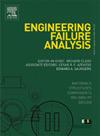Influence of microstructural gradient on Charpy V-notch impact toughness variability in X65 pipeline girth weld
IF 5.7
2区 工程技术
Q1 ENGINEERING, MECHANICAL
引用次数: 0
Abstract
This study investigates the ductile-to-brittle transition behaviour of weld metal in a multipass girth weld extracted from a North American CO2 steel pipeline (X65 grade), with a focus on understanding the causes of scatter in Charpy V-notch (CVN) impact energy values, particularly between −60 °C and −25 °C. CVN specimens were tested between −80 °C and 25 °C, and selected samples underwent post-test characterization to correlate fracture behaviour with microstructural variation through the weld thickness. Fracture surfaces and microstructures along the notch front and fracture edges were examined using optical microscopy, scanning electron microscopy, and electron backscattered diffraction. The results showed that the observed scatter in toughness data was primarily due to variations in the extent of the coarse columnar ferritic structure zone intersecting the CVN notch front. This microstructure, predominantly found in the weld cap and outer fill passes, was associated with lower impact toughness. A low density of high-angle grain boundaries (HAGBs) in these regions reduced resistance to crack propagation, contributing to the formation of large cleavage facets. The alignment of {001} cleavage planes with fracture edges and the presence of microcracks further highlighted the role of crystallography in fracture behaviour. Conversely, zones with finer equiaxed grains, present in the initial fill passes and characterized by a high density of HAGBs, exhibited enhanced plasticity and absorbed higher energy. The proposed integrated approach provides a microstructure-sensitive framework for interpreting scatter in weld metal toughness, supporting improved structural integrity assessments for pipeline welds.
组织梯度对X65管道环焊缝Charpy v型缺口冲击韧性变化的影响
本研究研究了从北美CO2钢管道(X65级)中提取的多道焊缝金属的韧性到脆性转变行为,重点是了解Charpy v缺口(CVN)冲击能值散射的原因,特别是在- 60°C和- 25°C之间。CVN试样在- 80°C和25°C之间进行测试,并对选定的试样进行测试后表征,以通过焊缝厚度将断裂行为与显微组织变化联系起来。利用光学显微镜、扫描电镜和电子背散射衍射对缺口前缘和断口边缘的断口表面和微观结构进行了检测。结果表明,韧性数据的分散主要是由于与CVN缺口前缘相交的粗柱状铁素体结构区范围的变化。这种组织主要存在于焊帽和外填充孔道中,与较低的冲击韧性有关。这些区域的低密度高角晶界(HAGBs)降低了裂纹扩展的阻力,导致了大解理面的形成。{001}解理面与断口边缘的排列和微裂纹的存在进一步突出了晶体学在断裂行为中的作用。相反,在初始填充过程中具有更细等轴晶的区域,以高密度的HAGBs为特征,表现出更高的塑性和吸收更高的能量。所提出的综合方法为解释焊缝金属韧性中的散射提供了一个微观结构敏感的框架,支持改进管道焊缝的结构完整性评估。
本文章由计算机程序翻译,如有差异,请以英文原文为准。
求助全文
约1分钟内获得全文
求助全文
来源期刊

Engineering Failure Analysis
工程技术-材料科学:表征与测试
CiteScore
7.70
自引率
20.00%
发文量
956
审稿时长
47 days
期刊介绍:
Engineering Failure Analysis publishes research papers describing the analysis of engineering failures and related studies.
Papers relating to the structure, properties and behaviour of engineering materials are encouraged, particularly those which also involve the detailed application of materials parameters to problems in engineering structures, components and design. In addition to the area of materials engineering, the interacting fields of mechanical, manufacturing, aeronautical, civil, chemical, corrosion and design engineering are considered relevant. Activity should be directed at analysing engineering failures and carrying out research to help reduce the incidences of failures and to extend the operating horizons of engineering materials.
Emphasis is placed on the mechanical properties of materials and their behaviour when influenced by structure, process and environment. Metallic, polymeric, ceramic and natural materials are all included and the application of these materials to real engineering situations should be emphasised. The use of a case-study based approach is also encouraged.
Engineering Failure Analysis provides essential reference material and critical feedback into the design process thereby contributing to the prevention of engineering failures in the future. All submissions will be subject to peer review from leading experts in the field.
 求助内容:
求助内容: 应助结果提醒方式:
应助结果提醒方式:


